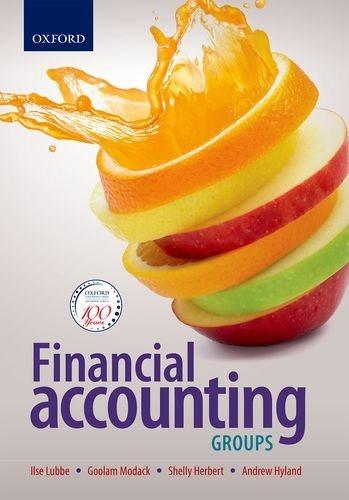Question
Problem 5-19A (Algo) Effect of different inventory cost flow methods on financial statements LO 5-1 The accounting records of Wall's China Shop reflected the following
 Problem 5-19A (Algo) Effect of different inventory cost flow methods on financial statements LO 5-1 The accounting records of Wall's China Shop reflected the following balances as of January 1, Year 2. Cash $ 18,100 Beginning inventory 13,330 (155 units @ $86) Common stock 15,700 Retained earnings 15,730 The following five transactions occurred in Year 2: First purchase (cash): 120 units @ $88 Second purchase (cash): 195 units @ $96 Sales (all cash): 420 units @ $195 Paid $14,300 cash for salaries expenses Paid cash for income tax at the rate of 40 percent of income before taxes Required a. Compute the cost of goods sold and ending inventory, assuming (1) FIFO cost flow, (2) LIFO cost flow, and (3) weighted-average cost flow. Compute the income tax expense for each method. b. Record the above transactions in general journal form and post to T-accounts assuming each of the cost flows listed. Assume perpetual inventory system is used. 1. FIFO 2. LIFO 3. Weighted Average c. Use a vertical model to show the Year 2 income statement, balance sheet, and statement of cash flows under FIFO, LIFO, and weighted average.
Problem 5-19A (Algo) Effect of different inventory cost flow methods on financial statements LO 5-1 The accounting records of Wall's China Shop reflected the following balances as of January 1, Year 2. Cash $ 18,100 Beginning inventory 13,330 (155 units @ $86) Common stock 15,700 Retained earnings 15,730 The following five transactions occurred in Year 2: First purchase (cash): 120 units @ $88 Second purchase (cash): 195 units @ $96 Sales (all cash): 420 units @ $195 Paid $14,300 cash for salaries expenses Paid cash for income tax at the rate of 40 percent of income before taxes Required a. Compute the cost of goods sold and ending inventory, assuming (1) FIFO cost flow, (2) LIFO cost flow, and (3) weighted-average cost flow. Compute the income tax expense for each method. b. Record the above transactions in general journal form and post to T-accounts assuming each of the cost flows listed. Assume perpetual inventory system is used. 1. FIFO 2. LIFO 3. Weighted Average c. Use a vertical model to show the Year 2 income statement, balance sheet, and statement of cash flows under FIFO, LIFO, and weighted average.
Step by Step Solution
There are 3 Steps involved in it
Step: 1

Get Instant Access to Expert-Tailored Solutions
See step-by-step solutions with expert insights and AI powered tools for academic success
Step: 2

Step: 3

Ace Your Homework with AI
Get the answers you need in no time with our AI-driven, step-by-step assistance
Get Started


